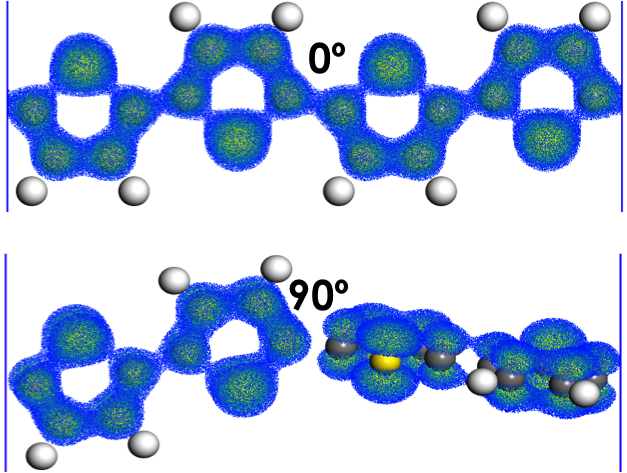Organic Electronics
Janik, Milner
Research Highlights
Charge Transport in Organic Polymer Semiconductors
Organic electronic materials can provide the mechanical and chemical flexibility needed for conformal lighting, energy harvesting technologies, personal electronics with foldable form factors, and next-generation battery electrodes. DFT methods can serve as an essential tool for developing the composition-structure-function relationships that dictate performance in these technologies. CoMET research concentrates on polymeric materials, namely on 1) the impact of interfacial structure on charge transfer and separation at organic electronic heterojunctions and 2) the coupling of electron transport and nuclear motion through multi-scale simulation. Both of these efforts integrate DFT methods with larger scale simulations that consider the impact of long-range structure on electron transport properties.
Motivated by their electronic and mechanical properties combined with low cost and ease of processing, conjugated polymers have found promising application as active elements in organic semiconductor devices. However the low charge mobilities, attributed to disorder in these materials compared to inorganic semiconductors have limited their widespread usage. Polymers are soft materials with high levels of conformational degrees of freedom, and therefore highly disordered. Transport in conjugated polymers is poorly understood and this hampers the design and sustained development of new high performance polymer semiconductors. An accurate description of electronic transport in these materials requires an effective account of the interaction with nuclear degrees of freedom. The representation of this coupling is particularly challenging for these soft materials. We use a mixed quantum and classical approach based on the Tight Binding approximation to model the electronic degrees of freedom of the polymer, taking into account atomic coordinates changes. Coarse graining is employed to allow access to larger length and time scales. The model uses molecular and electronic structure information obtained using DFT. The nuclei are treated classically, and information from classical MD is used. An initial success of this approach is the ability to replicate the broadening of the absorption spectrum of a dilute polymer by capturing the impact of dihedral fluctuations on the band structure of polythiophene.
